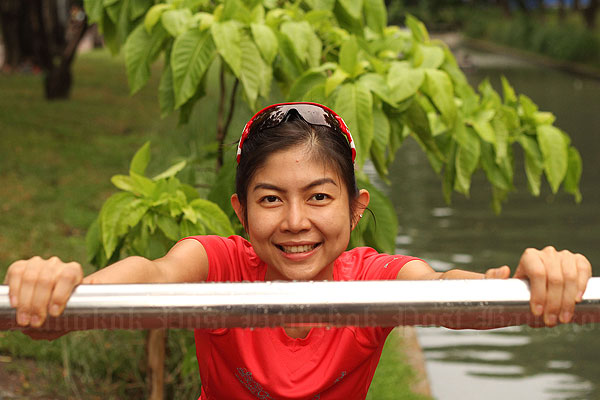
By Ajarn Helen Jandamit
Photos courtesy of Bangkok Post
University Tips is here to help you prepare for the English exams and tests that are coming your way. It gives you practise answering questions similar to those you may have at school and also on the University Entrance Examination.
Read the following story by Atiya Achakulwisut from the Bangkok Post. Then, answer the questions that follow.
Imagine covering a distance of 112.5 kilometres on foot. Imagine running for 19 hours along hilly, winding roads and all through the night with only a small headlamp to light the way. Imagine the fatigue, the fear and the crippling pain.
Pakanee Burutphakdee, 29, never imagined she’d be able to run so far for so long, but she did. In June last year she became the first and only woman to date to have finished the Ocean-to-Ocean (O-to-O) run from Ranong to Chumphon.
The long-distance event, held this year for the third time, starts on Thailand’s Indian Ocean coastline and finishes up on the other side of the Malay Peninsula in a province which overlooks the Pacific Ocean.
The O-to-O is intended to be a relay race for eight-member teams, but Pakanee ran the whole distance herself with only one running companion.
“The first time I heard about a 100 kilometre run, I was shocked that such a thing even existed,” she said. “I thought that anybody who chooses to do something like that must be crazy.”
Before she began running two years ago, Pakanee was one of those young women who didn’t want to exercise outdoors.
“The maximum distance I would run in those days was two or three kilometres,” she recalled.
In 2012, however, she was persuaded to take part in a 10 kilometre running event. It was that experience that got her hooked.
“It was torture,” Pakanee said. “I was so tired and I felt terrible, but as soon as I saw the finish line, all the misery disappeared.”
That sense of accomplishment made her go on. She ran in a half-marathon in late 2012. The next year, she felt ready to try a full marathon. Over the two months that followed, she finished two more marathons, improving her time by nine minutes for the third event.

People tried to talk Pakanee out of entering the 112.5 kilometre Ocean-to-Ocean run, but they made her more determined to try. She later said it was the toughest running experience she has ever had.
Because they were not part of a relay team, Pakanee and her running partner were allowed to start on June 14, earlier than the other competitors. They were allowed to pause for a few minutes every 5 kilometres to have a snack or make a toilet stop.
“I was very scared when it started to get dark,” Pakanee said.
They had to be aware of approaching traffic all the time. The scariest part of that night-time run, however, was ferocious dogs.
“I had to carry a stick all the way,” she said. “We were very scared of the dogs.”
Pakanee started to feel pain in her legs after covering 30 kilometres. At 50 kilometres, her ankles were badly swollen. An analgesic spray and painkillers kept her running until she reached 100 kilometres.
“At that point, I felt so much pain that I was nearly crying,” she said. “The sun was rising and the sky was beginning to get brighter, and I could see the road stretching ahead of me once again.”
The last leg of the event turned out to be the most tortuous 10 kilometres she’d ever run in her life.
“My swollen ankles hurt and after the 105th kilometre I could no longer run, so I had to walk.”
It took Pakanee three hours to cover that last 11 kilometres.
“As soon as I saw the finish-line, I started running towards it,” she said. “I could no longer feel my ankles at that point!”
Exercises
Section 1
Read the story and answer the following multiple-choice questions.
1. What is the distance of the O-to-O marathon?
a. 100 kilometres.
b. 105 kilometres.
c. 112.5 kilometres.
2. Where does the O-to-O run start?
a. Ranong.
b. Chumphon.
c. A province which overlooks the Pacific Ocean.
3. Who is the Ocean-to-Ocean run intended for?
a. One runner with a companion.
b. Teams with eight members.
c. Individuals.
4. What was the most frightening thing for Pakanee about the night-time run?
a. Approaching traffic.
b. Ferocious dogs.
c. A small headlamp.
5. When did Pakanee become the first and only woman to have finished the Ocean-to-Ocean run?
a. In June last year.
b. 10 years ago.
c. The story does not say.
6. What is Pakanee’s surname?
a. Satrabhaya.
b. Achakulwisut.
c. Burutphakdee
7. Why did Pakanee say that the Ocean-to-Ocean run was torture?
a. She had to run for 19 hours along hilly, winding roads.
b. She had to run at night along dangerous roads that had ferocious dogs and traffic.
c. Both a and b are correct.
8. What does "O-to-O" stand for?
a. Ocean-to-Ocean
b. Over-to-Over.
c. Onion-to-Oven.
Section 2
Read the story and decide whether the following statements are true or false.
9. Ocean-to-Ocean is a swimming competition.
………………..
10. Pakanee is 19 years old.
………………..
11. Pakanee ran in the Ocean-to-Ocean race alone.
………………..
12. An analgesic spray and painkillers kept Pakanee running until the end of the O-to-O event.
………………..
Section 3
Fill in the blanks in the following passage with the correct words from the choices given.
Pakanee noted that while some people run for specific …..13….., such as to lose weight or to …..14….. their fitness levels, she has …..15….. such ulterior motives.
“I run simply because I feel …..16….. to run,” Pakanee said. “When I run, I don’t think too …..17….. . I just run to be with myself.”
13.
a. purpose
b. purposes
c. on purpose
14.
a. improving
b. improvement
c. improve
15.
a. nothing
b. no
c. none
16.
a. happy
b. unhappy
c. happiness
17.
a. much
b. more
c. the most
Section 4
Write down the noun forms of the following words used in the story.
18. imagined …………….
19. young …………….
20. felt …………….
Section 5
Read the following sentences. Then, underline the grammatically correct word in each from the choices given.
21. It was the most difficult experience she has even/ever/never had.
22. She started to feel pained/pain/paining in her legs.
23. She was scared what/when/how it was getting dark.
24. The maximum distance she would run in those days was a few/more/any kilometres.
Vocabulary
- hilly (adj): having a lot of hills
headlamp (n): a large light, usually one of two, at the front of a vehicle
accomplishment (n): the successful completing of something
determined (adj): having made a firm decision to do something
ferocious (adj): very fierce, violent or aggressive
analgesic (n): a substance that reduces pain


